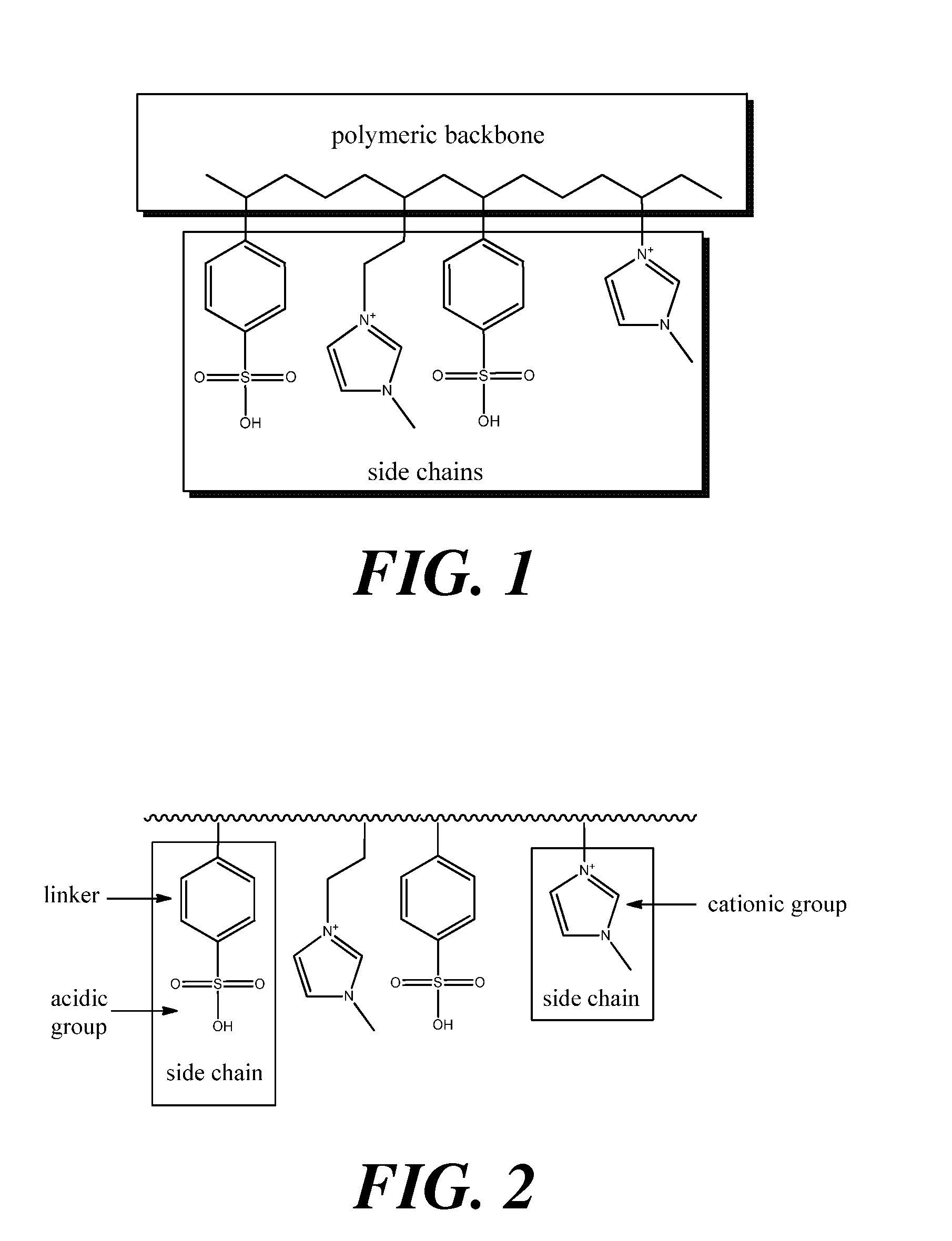Polymeric acid catalysts and uses thereof
a polysaccharide and catalyst technology, applied in the field of catalysts, can solve the problems of inability to achieve appreciable digestion of cellulose or hemicellulose, inability to achieve cellulose or hemicellulose crystalline domains, inability to achieve cellulose or hemicellulose appreciable digestion, etc., to achieve the effect of promoting the break-down of tertiary structure and readily forming glycosidic bonds of polysaccharides
- Summary
- Abstract
- Description
- Claims
- Application Information
AI Technical Summary
Benefits of technology
Problems solved by technology
Method used
Image
Examples
example 1
Preparation of poly[styrene-co-vinylbenzylchloride-co-divinylbenzene]
[0525]To a 500 mL round bottom flask (RBF) containing a stirred solution of 1.08 g of poly(vinylalcohol) in 250.0 mL of deionized H2O at 0° C., was gradually added a solution containing 50.04 g (327.9 mmol) of vinylbenzyl chloride (mixture of 3- and 4-isomers), 10.13 g (97.3 mmol) of styrene, 1.08 g (8.306 mmol) of divinylbenzene (DVB, mixture of 3- and 4-isomers) and 1.507 g (9.2 mmol) of azobisisobutyronitrile (AIBN) in 150 mL of a 1:1 (by volume) mixture of benzene / tetrahydrofuran (THF) at 0° C. After 2 hours of stiffing at 0° C. to homogenize the mixture, the reaction flask was transferred to an oil bath to increase the reaction temperature to 75° C., and the mixture was stirred vigorously for 28 hours. The resulting polymer beads were vacuum filtered using a fritted-glass funnel to collect the polymer product. The beads were washed repeatedly with 20% (by volume) methanol in water, THF, and MeOH, and dried ove...
example 2
Preparation of poly[styrene-co-3-methyl-1-(4-vinylbenzyl)-3H-imidazol-1-ium chloride-co-divinylbenzene]
[0526]Poly(styrene-co-vinylbenzylchloride-co-divinylbenzene) (Cl− density=˜4.0 mmol / g, 50 g, 200 mmol) was charged into a 500 mL three neck flask (TNF) equipped with a mechanical stirrer, a dry nitrogen line, and purge valve. Dry dimethylformamide (185 ml) was added into the flask (via cannula under N2) and stirred to form a viscous slurry of polymer resin. 1-Methylimidazole (36.5 g, 445 mmol) was then added and stirred at 95° C. for 8 h. After cooling, the reaction mixture was filtered using a fritted glass funnel under vacuum, washed sequentially with de-ionized water and ethanol, and finally air dried.
[0527]The chemical functionalization of the polymer material, expressed in millimoles of functional groups per gram of dry polymer resin (mmol / g) was determined by ion exchange titrimetry. For the determination of cation-exchangable acidic protons, a known dry mass of polymer resin...
example 3
Preparation of poly[styrene-co-4-vinylbenzenesulfonic acid-co-3-methyl-1-(4-vinylbenzyl)-3H-imidazol-1-ium bisulfate-co-divinylbenzene]
[0528]Poly[styrene-co-3-methyl-1-(4-vinylbenzyl)-3H-imidazol-1-iumchloride-co-divinylbenzene] (63 g) was charged into a 500 mL flask equipped with a magnetic stir bar and condenser. Cold concentrated sulfuric acid (>98% w / w, H2SO4, 300 mL) was gradually added into the flask under stirring which resulted in formation of dark-red colored slurry of resin. The slurry was stirred at 85° C. for 4 h. After cooling to room temperature, the reaction mixture was filtered using fritted glass funnel under vacuum and then washed repeatedly with de-ionized water until the effluent was neutral, as determined by pH paper. The sulfonated resin beads were finally washed with ethanol and air dried. The chemical functionalization of the polymer resin with sulfonic acid groups was determined to be 1.60 mmol / g, as determined by titrimetry following the procedure of Exampl...
PUM
| Property | Measurement | Unit |
|---|---|---|
| catalytic properties | aaaaa | aaaaa |
| insoluble | aaaaa | aaaaa |
| magnetic | aaaaa | aaaaa |
Abstract
Description
Claims
Application Information
 Login to View More
Login to View More - R&D
- Intellectual Property
- Life Sciences
- Materials
- Tech Scout
- Unparalleled Data Quality
- Higher Quality Content
- 60% Fewer Hallucinations
Browse by: Latest US Patents, China's latest patents, Technical Efficacy Thesaurus, Application Domain, Technology Topic, Popular Technical Reports.
© 2025 PatSnap. All rights reserved.Legal|Privacy policy|Modern Slavery Act Transparency Statement|Sitemap|About US| Contact US: help@patsnap.com



